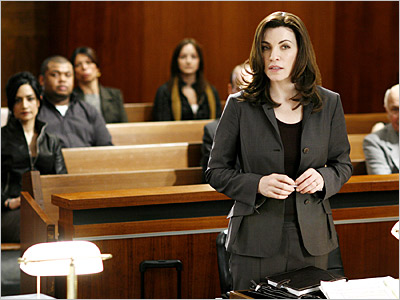A last minute hearing before Judge Barbara Kapnick in New York Supreme Court on Tuesday provided drama worthy of prime time television, illustrating the stakes of the trial beginning today between MBIA, the New York Insurance Department (“NYID”), and Bank of America (“BofA”) over the propriety of the bond insurer’s 2009 restructuring. The telephonic hearing held on May 8 (the “May 8 Hearing,” transcript available here) centered largely on the scope of the Article 78 proceeding, something that Judge Kapnick had addressed at length at a prior hearing on April 20, but about which the parties still appeared to have widely differing views. This led to heated arguments and an exasperated judge, who ultimately was forced to hang up on the parties when they continued to argue after their allotted time was up.
As an attorney, I’m not usually one for fictional courtroom dramas, probably for the same reasons that my cardiologist father never wanted to watch ER and the firefighters I know couldn’t stand the movie Backdraft. It’s hard to enjoy a fictional work about a profession you live  and breathe daily, especially when the dramatic plot twists make it almost laughably unrealistic. (I have to admit that I make an exception for The Good Wife, as the topical story lines and character development allow me to overlook the unrealistic courtroom scenes – most of the time.)
and breathe daily, especially when the dramatic plot twists make it almost laughably unrealistic. (I have to admit that I make an exception for The Good Wife, as the topical story lines and character development allow me to overlook the unrealistic courtroom scenes – most of the time.)
But as I read through the transcript of Tuesday’s hearing, I wondered whether I was being too hard on courtroom dramas. In fact, if I had seen the kind of last minute shenanigans depicted in the transcript unfold in one of these television programs, I probably would have scoffed at the absurdity of it all. When would the parties ever show up in front of a judge on the eve of trial and argue over whether there was a need for a trial at all? I wouldn’t have believed it; but reading the saga unfold in a real life transcript, I couldn’t put it down. For those of you who don’t view hearing transcripts as page-turners, I will try to summarize the major takeaways from Tuesday’s hearing, with plenty of quotes thrown in to give you the flavor of the proceedings.
Rundown of May 8 Telephonic Hearing
Though buried in a slew of references to cases and statutes, the gist of the argument playing out on the phone before Judge Kapnick on Tuesday was that BofA wanted a ruling that there was going to be a full blown trial starting today on whether MBIA’s 2009 restructuring was improper, while MBIA and the NYID wanted the Judge to hold a “summary proceeding” and restrict the material that could be presented. Essentially, MBIA and the NYID wanted the Judge to drive the proceedings, and restrict BofA to presenting only the evidence Her Honor determined she needed to evaluate a genuine issue of fact. Each party relied on statements Kapnick made during the April 20 hearing to support its respective position.
BofA’s attorney, Robert Giuffra from Sullivan & Cromwell, stated that, “on April 20, the Court could not have been clearer that the parties were having a trial starting on May 14.” (May 8 at 4:8-9.) He focused on Kapnick’s use of the word “trial” during the prior proceeding, noting that Her Honor had used the word over 40 times and that BofA thus understood from the April 20 hearing that there would be a full trial. (May 8 Hearing at 5:21-23.) However, anyone who read that prior transcript or my prior article will recall that Kapnick used many different words to describe the proceeding that would begin this week, and indicated she didn’t place much importance on the name, saying:
I have made that very clear from the outset, that it is, whether you call it a trial, I said I don’t want to fight about the semantics, whether you call it a trial or a hearing with evidence. I think everybody understands. (April 20 Hearing 44:18-22.)
Clearly, Her Honor was mistaken, because when MBIA attorney Marc Kasowitz, from Kasowitz Benson Torres & Friedman LLP, was allowed to respond, he stated that “nothing could be further from the truth,” as MBIA’s understanding was that the Court was going to hold an “Article 78 summary proceeding.” (May 8 Hearing at 8:3-7.) Also drawing from statements Her Honor made at the April 20 Hearing, Kasowitz argued that,
the summary proceeding should go as the Court indicated in the last conference, i[n] that there should be argument by other lawyers, other parties, to present to the Court the evidence that has been adduced during the course of this proceeding. And if there are issues of fact, if there is an issue of fact or issues of fact, then the Court can try those issues and if the Court would like to hear from witnesses, then the Court can say I would like to hear from some witnesses on some of the issues of fact… (May 8 Hearing 10:5-14.)
In her response to these widely differing views, Kapnick sought to clarify her position, saying, “Well, I mean, I guess this goes back to are there any issues of fact that need to be tried. Obviously, this is not a trial de novo and this is not — I mean, I have a relatively simple ‘determination’ as to whether or not the Superintendent’s determination, the Department of Insurance’ determination was arbitrary and capricious…” (May 8 Hearing at 13:7-13.) The Judge went on to note that she did not view the issue of whether the NYID’s decision was arbitrary and capricious itself as an issue of fact, but instead as the ultimate issue she would be asked to determine.
This explanation did little to placate the parties. Eventually, the NYID’s attorney, David Holgado, from the Office of the New York Attorney General, was allowed to chime in, and largely supported MBIA’s position, noting,
the hearing that your Honor really was contemplating is…[one in which] your Honor should hear argument from the parties regarding the papers that have already been submitted and that you may, as Mr. Kasowitz pointed out, ask for submission of additional proof, which is the sum testimony that your Honor mentioned in addition to the ‘glorified oral argument’ that you envisioned for this hearing. We have no issue whatsoever with what your Honor stated at the April 20th conference and we certainly have been trying to follow it faithfully in preparation for trying it. (May 8 Hearing at 15:15-16:3.)
Holgado also noted that the reason BofA was trying to turn the proceeding into a full blown trial was so that it could apply the formal rules of hearsay to exclude the affidavits presented by NYID staff and elicit their statements de novo. Holgado referred to those arguments at “specious” and argued that the Court should “of course consider” the submissions that have already been made by the Department, at which point he was interrupted by Giuffra. (May 8 Hearing at 19-20.)
However, Giuffra did not get far before being interrupted in turn by Kapnick, who challenged BofA’s attempts to strike portions of the administrative record:
But let me just interrupt you. I mean, I understand that on a trial, there are evidentiary rules. But you can’t tell me that all of those affidavits are excluded now because maybe some of the things in them are — do not comport exactly with the evidentiary rules. I mean, that I cannot accept. I mean, I cannot accept that you’re not trying to throw out all of the documents that you just spent the past three years submitting. That is part of the record. (May 8 Hearing at 19:19-20:2.)
Kapnick also began to express frustration with BofA’s extreme position and their attempts to lock Her Honor into a ruling she didn’t believe she made, saying:
I mean, I don’t agree with you, Mr. Giuffra. I mean, it is very nice that somebody went through and counted how many times the word trial was used in the transcript. I don’t have the time to do that or the interest or maybe the court reporter put that in the end or something like that, but I envisioned not your standard trial, and I think that is what I said at the end, even though I said some type of trial, but sort of in quotation marks. (May 8 Hearing at 20:23-21:5)
So we know that we will be seeing a “trial” starting today, but it won’t necessarily look like your typical trial. Of course, that begs the question: of what will this “trial” actually consist? Ultimately, Kapnick attempted to articulate how she envisioned the May 14 proceeding, and it sounded awfully similar to the way MBIA and the NYID described it:
really, this is a presentation by you [BofA] as to why you believe that you have enough information to suggest that or to prove that, to support your petition that this determination by the State Insurance Fund was arbitrary and capricious and abuse of discretion. I mean, that is really the standard that I am bound by, by Article 78.
If, as we are going through this, somehow there is an issue of fact, I mean, an issue of fact would be I thought that the Insurance Department had these 4,500 pages in front of them and now I learn they didn’t and there is an issue as to did they have them or didn’t they have them…
[I]f during the argument or during the presentation of your — of the case, through the motion and whatever else you want to say, that there are significant issues of fact that are raised, that then you think there should be some type of hearing or trial on that issue, then we will have to deal with that, but I don’t — I think that — I thought that I did not say this was a full blown trial that I might have in a lot of other cases because it is an Article 78 proceeding which usually does not have a trial… (May 8 Hearing at 21:6-22:22.)
However, this did not stop the parties from continuing to argue their positions, and despite Her Honor’s repeated warnings about the need to wrap up the hearing, they went back and forth for several more rounds on the structure and nature of today’s “trial” before Kapnick had finally had enough.
Judge Kapnick Reaches Her Limit
Ultimately, even the most patient judge reaches a breaking point, and Judge Kapnick is no different. For me, despite all of the fireworks between the parties, the most colorful aspects of Tuesday’s proceeding came from the Judge herself, who was clearly taken aback by the vitriol between the parties and their inability to agree to even the most basic issues:
I mean, nobody seems to listen to anything I said last time. You all stuck to exactly your guns like we weren’t here for 65 pages on the transcript. You’re all interpreting it in certain ways. I guess I hope that you would sort of understand what I was saying, but I guess you don’t. (May 8 Hearing at 23:18-23.)
Later, Her Honor added,
I mean, you’re trying to pigeonhole me into calling something something that I have not said. I will go back and read all 65 pages over the weekend, but that is not what I said…
So I mean, I never had so much time on a phone with whether it is a hearing or a preliminary injunction, a hearing, or a trial, or whatever. I never have that and I mean, this is really a very unique situation. So I am sorry if I have not been as clear as you think I should have been. Mea culpa. (May 8 Hearing at 29:12-15; 31:8:13.)
This building frustration finally boiled over when the parties could not even agree as to the order in which they would deal with issue’s at the start of today’s proceedings. After repeatedly warning the parties that time was short, and that she needed to break to give her staff time for lunch before her afternoon calendar, Her Honor finally reached her limit when the parties continued to argue over whether the judge would begin today’s “trial” by deciding evidentiary motions or deal first with determining the relevant issues of fact. This is where the Judge finally stepped in:
I will tell you what. I am really sorry that there is nothing you can agree on. I am really very sorry. I am not used to this and for lawyers of this caliber to disagree on every single thing, not cooperate with each other on anything. I don’t have time. I am sorry, my court reporter is looking at me and I have to hang up. (May 8 Hearing at 33:7-13.)
Ultimately, that is exactly what the judge did, over the parties’ continued efforts to get in a final word, saying “No. Bye bye now. I have to go.” (May 8 Hearing at 35:10-11.)
If this level of contentiousness is any indication of the fireworks we will see at the Article 78 “trial” over the next few weeks, then we are in for some real life courtroom drama that would make the writers of The Good Wife proud. So, as Terrell Owens says, “grab your popcorn.” Bet-the-company litigation of the sort currently playing out between MBIA and BofA does not come along often, but when it does, the drama should be well worth watching.
[Author’s Note: I will not be able to attend the “trial” this week in New York, but if any loyal readers are in attendance, please email me or post comments with any thoughts, reactions, or particularly colorful moments – IMG]





